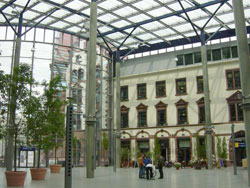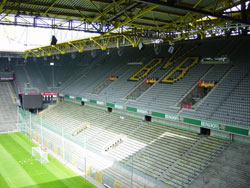
Germany 2006 FIFA World Cup VenuesFIFA World Cup Host Cities - DORTMUNDDortmund city profile
With the downfall of the old German Empire, the Imperial City of Dortmund lost its autonomy, and was occupied soon after by the French. The introduction of Bavarian brewing techniques in 1845 led to the establishment of modern large-scale beer brewing facilities. Major industrial advances, such as the "blowing in" of the first blast furnace in the Dortmund area, heralded the ascent of heavy industry. Between 1871 and 1873, three collieries commenced coal mining. With a population that had grown to 140,000, Dortmund entered the 20th century as the largest and most important industrial city in the Ruhr area. Bomb raids during World War II destroyed 95 percent of the old inner city and 60 percent of the residential areas. Dortmund was rebuilt by the 1960's, and is now an internationally renowned centre of technology, research and culture, forming the heart of Westphalia. Sports are enormously popular among the population of Dortmund: More than 135,000 sports activists are organized in 600 sports clubs. The outstanding club in the football sector is 1997 UEFA Champions League winner and 1997 Cup winner Borussia Dortmund. Dortmund has hosted outstanding sporting events (1989 world table tennis championship, 1989 German swimming championship, 1990 DJK national sports festival, and the 28th German Gymnastics Meeting in 1990), and is the location of major annual international events such as the Dortmund Six Day Race, the International Riding and Jumping Competition and the DJV Track and Field Meeting. Major Events at the former Dortmund Westfalenstadion
Dortmund stadium profilePopulation: 590,000
In November 2001, the authorities resolved to join up the four separate stands, increasing the all-seat capacity to around 67,000. Crucially, the design carefully allows proper ventilation for the pitch. This temple of football on Strobelallee features more than 3,500 food service points, another best-in-class figure for the Bundesliga. This phase of the reconstruction project was completed in late summer 2003. A further modernisation programme took place in summer 2005. The seats in the lower tier were equipped with back rests and a new VIP section opened. An electronic access control system was installed and began operations, together with refurbishment of the dressing room and team zones. Eight 62-metre-high bright yellow support pylons represent a distinctive, colourful landmark on the Dortmund skyline. At the 2006 FIFA World Cup, the steel exterior structure will be visible from miles away as visitors from all over the globe flock to the Westfalenstadion, a venue for one of the semi-finals. Planning for what was to become one of the world's great stadiums began in the early 1960s. An initial proposal to expand the venerable "Rote Erde" stadium was abandoned in 1965 in favour of constructing a so-called twin stadium on the site next to the "Rote Erde". Costs were halved by the novel concept of modular construction involving pre-cast building elements. Some 50,000 cubic metres of earth were excavated, as bomb disposal teams uncovered, defused and removed 34 Second World War bombs. Surveying the finished product, then Germany boss Helmut Schön was overwhelmed at what he saw: "There's only one football stadium better than this in the whole world, the Azteca in Mexico City." Quipped Cologne midfielder Wolfgang Overath: "There's just one thing wrong with it - it's not in Cologne." Financing: (*) "Total Seating Capacity" means the Gross Capacity less the seats unavailable for use due to restricted views and security/contingency reserves for the 2006 FIFA World Cup. This capacity is estimated and may change once these deductions are finally determined.
|
|
||||||||||||||||||||||
Recommended Sportsbook
Bookmaker Sportsbook is a recognized sports betting leader since 1985. BookMaker provides safe, legal, and secure betting on major sporting events, as well as horse racing, casino, and poker entertainment, from any location in the world, 24 hours a day 7 days a week. Bookmaker is the number one legal online sports betting and entertainment center of America. Bonded and fully licensed by the Government of Costa Rica. With a reputation like this everyone should have an account.
Bookmaker covers all needs for any real gambler. If you do not have an account with Bookmaker you are making a very big mistake. Signing up now is better than ever as gives you the best bonuses available. With an array of bonuses and the best reputation, Bookmaker is a must have for A list sportsbook betting fans. Sign up today!
 The first documented mention of Dortmund dates back to between 880 and 890. In the 13th century, Dortmund was one of the wealthiest and most powerful cities in the Hanseatic League. As a Free Imperial City in the 18th century, Dortmund had to swear allegiance to the new monarch each time a king was enthroned, and petition confirmation of its rights and privileges.
The first documented mention of Dortmund dates back to between 880 and 890. In the 13th century, Dortmund was one of the wealthiest and most powerful cities in the Hanseatic League. As a Free Imperial City in the 18th century, Dortmund had to swear allegiance to the new monarch each time a king was enthroned, and petition confirmation of its rights and privileges.  Known nationwide as the Bundesliga’s opera house, the Westfalenstadion was originally built for the 1974 FIFA World CupTM. Borussia Dortmund play their home games here, practically always in front of sell-out crowds. Some 25,000 of these fans roar on their beloved Borussia from the famous South Stand terraces, an awesome and fearful prospect for the visiting team. No fewer than 1.4 million spectators thronged to Germany's biggest stadium in 2004-5, making an average of over 77,000 and a Bundesliga and European record.
Known nationwide as the Bundesliga’s opera house, the Westfalenstadion was originally built for the 1974 FIFA World CupTM. Borussia Dortmund play their home games here, practically always in front of sell-out crowds. Some 25,000 of these fans roar on their beloved Borussia from the famous South Stand terraces, an awesome and fearful prospect for the visiting team. No fewer than 1.4 million spectators thronged to Germany's biggest stadium in 2004-5, making an average of over 77,000 and a Bundesliga and European record.